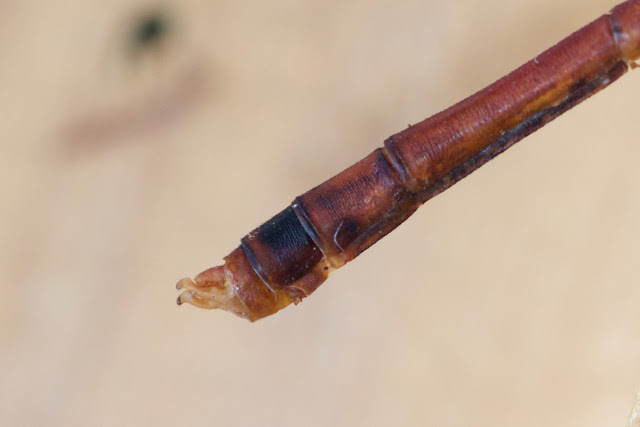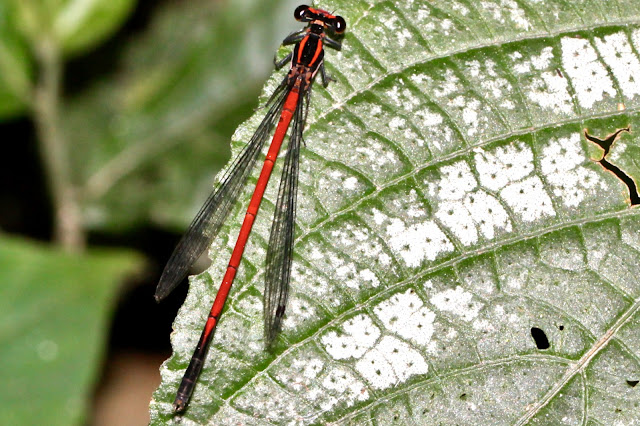Family Platycnemididae or Brook Damselflies
Coeliccia renifera
(Selys, 1886)
Elevation 800 - 1600m
Abdomen Length 33-37mm
Along seepages and slow streams, these beautiful green and black damselflies are spotted mostly by their white anal appendages and the bright green markings on their thorax. Females are less brightly marked and can vary in color according to age - from bright yellow to muted green. They range across the mid-hills in the Himalayas from NW India to NE India including Nepal and probably Bhutan. They appear just before the monsoon in June, and breed in June and September.
Male
Female
Calicnemia doonensis carminea
Lieftnick 1984
Elevation 500-1700
Abdomen length 33-34mm
Endemic to Nepal. There has been some discussion as to whether or not this is a valid species and what name it should be given since there were several published records from Dehra Dun India in 1984 and by Hämäläinen (1989) who made several interesting observations; first, this Calicnemia has no relationship to C. miniata; second, it is the same taxon as C. carmine pyrrhosoma also from the same location but pre-dating the record. Another complication was a description of this Calicnemia by Lieftinck in 1984 of C. carminea carminea from Nepal, which has now been given subspecies status of C. doonensis. Currently, the nomenclature is unclear as to what the species name should be and if the Nepal species is the same as the Dehra Dun species.
The inferior anal appendages are longer than the superior. Older males tend to darken the lateral thorax to a dark purplish-blue. Usually, a good number are usually present when found, generally a tiny running stream with some seepage and lots of side vegetation. There are four known locations, Pokhara, mill stream on Daman Hwy, Tansen, and several roadside areas above Hetauda, at elevations between 900m and 1500m on perennial streams and seepages. It was mating in July with plenty of males and females present. One male was found in May with very light colors.
Male


Female
Calicnemia eximia
(Selys 1863)
Elevation 300 -2100m
Abdomen Length 30-34mm
They resemble other red Calicnemia sp. at first but when the small dot of yellow is seen on the humeral area of the thorax it is certain to be C. eximia. Males and females are similar except in coloration. They are usually found next to seepages similar to Drepanosticta locations and often in the same place. This one was near Mardi Khola on a rock wall beside a small stream. They are found from May through August and across the Himalayan region.
Male
Male
Female
Calicnemia miniata
(Selys 1886)
Elevation 800 to 1600m
Abdomen Length 30-32mm
This is a species from Ilam in east Nepal. The male is characterized by the bright red stripes on its black thorax with narrow yellow stripes laterally. The abdomen is bright red to the basal 1/3 of segment 7 the rest is black including the anal appendages. The female is a yellow and orange version of the male. They are not as common in Nepal as other Calicnemia relatives. These were photographed in May before the monsoon.
Male
Female
Calicnemia nipalica
Kimmins, 1958
Elevation 800 to 1600m
Abdomen Length 31mm
This is an uncommon wetland inhabitant in Nepal and is listed as vulnerable by IUCN. It rests along the seepages and small canals in darker areas of the jungle and might be easily overlooked. The color of the adult takes time to deepen. From its emergence, in mid-April, the male and female have similar colorations but by June the male's color deepens to a darker red and solid black toward the end of the abdomen. Mating is observed in late June and it is present through July.
Male
Female
Calicnemia pulverulans
(Selys, 1886)
Elevation 800 to 2000m
Abdomen length 29-31mm
C. pulverulans live in the same dark forested conditions as C. nipalica - they are often found nearby. The abdomen color is powdery blue as they pruinose early in life, overall it has a waxy blue color with some yellow to pale blue lateral thoracic stripes. A Himalayan native seen from NW India to NE India and into Myanmar. They are mostly found May through July mating in early May.
The common name is Yellow Feather Legs. Closely related to C. vittata, this species has bright yellow legs with expanded tibias. The pale bluish-white inferior appendages are nearly 4x the length of the small caudal (superior) appendages. The habitat is usually on slow-flowing rivers or muddy streams and lakes. White forms exist for both teneral males and females.


Long dark yellow-orange spidery legs without enlarged tibias, the longer caudal pointed anal appendages are ID indicators. There are several Copera sp that closely resemble each other and probably need a bit of work to separate them. C. vittata assamensis, C. vittata vittata, and C. marginipes are found in many regions across India and Southeast Asia. They are usually seen on slow or even slightly stagnate water and often in dark damp forested areas. Immature forms can be whitish in color and confusing at first glance.
Male
Copera marginipes
(Rambur, 1842)
Elevation 200-300m
Abdomen length 28-31mm
(Rambur, 1842)
Elevation 200-300m
Abdomen length 28-31mm
Male


Copera vittata
Selys, 1863
Elevation 200m
Abdomen length 28-34mm
Selys, 1863
Elevation 200m
Abdomen length 28-34mm
Long dark yellow-orange spidery legs without enlarged tibias, the longer caudal pointed anal appendages are ID indicators. There are several Copera sp that closely resemble each other and probably need a bit of work to separate them. C. vittata assamensis, C. vittata vittata, and C. marginipes are found in many regions across India and Southeast Asia. They are usually seen on slow or even slightly stagnate water and often in dark damp forested areas. Immature forms can be whitish in color and confusing at first glance.




























No comments:
Post a Comment